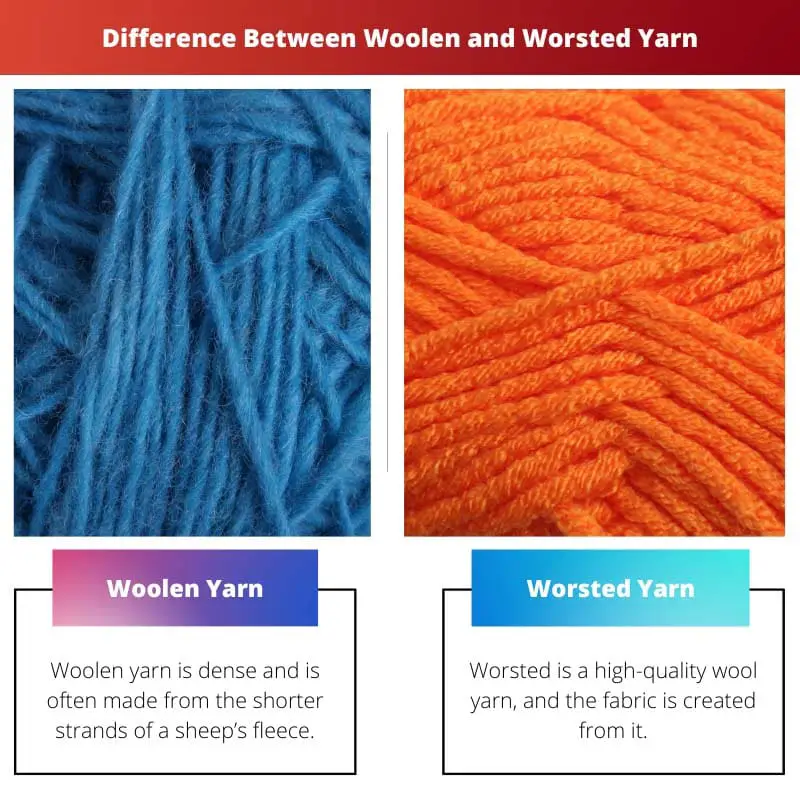The basic needs for the existence of human life are food, shelter, and clothing. The clothes that we wear protect us from scorching sun heat to the shivering winters.
These clothes are made from fibers or threads. Thread is a type of yarn, and wool is a fiber.
Different yarns serve different purposes.
Key Takeaways
- Woolen yarns have a soft, fuzzy texture, while worsted yarns are smoother and finer.
- Woolen yarns are less durable and more prone to pilling than worsted yarns.
- Worsted yarns provide better stitch definition and drape than woolen yarns in finished products.
Woolen vs Worsted Yarn
Woolen yarn is warmer and lighter weight than worsted yarn, making it a good choice for cozy, comfy clothing. Worsted yarn is heavier and more structured, making it better suited for tailored garments and home decor items. Woolen yarn also has a matte build, while worsted yarn has a slight sheen.

Woolen yarn is dense and is made from the shorter strands of a sheep’s fleece. Woolen yarn is soft, light, flexible, and breathable.
During spinning, the fibers in the woolen yarn are kept loosely and exposed to only a restricted or less twisted. The longest length of woolen yarn that can be produced from one pound is 54 hanks of 256 yards apiece.
Worsted is a high-quality wool yarn, and the fabric is created from it. The worsted yarn was created from long-staple pasture wool from domestic sheep including Teeswaters, Old Leicester Longwool, and Romney Marsh.
The toughest part of the procedure is brushing the short hair out of the fiber.
Comparison Table
| Parameters of Comparison | Woolen Yarn | Worsted Yarn |
|---|---|---|
| Spinning Technique | Traditionally carded | Combed |
| Length of Fibers | 1-3” | 3” |
| Fabric Appearance | Fuzzy, Heavier weight | Crisp, Smooth, Lighter weight |
| Durability | Less durable | More durable |
| Affordability | More affordable | Less affordable |
What is Woolen Yarn?
Woolen or woollen yarn is a form of carded wool yarn. It is an excellent insulator and a good knitting yarn.
Woolen yarn differs from worsted yarn in that the fibers are brushed rather than carded to produce a firm, robust yarn.
Wool (and other related animal fibers such as cashmere, camel, and so on) must be washed preceding mechanical processing in both the woolen and worsted processes.
Woolens refer exclusively to the textile processing of animal fibers, but it has become customary to use these names to refer to other fiber mixtures as well.
The resulting textiles will be labeled as woollen; however, this is done during the fiber processing and yarn production process, not in the cloth or final garment.
Carding and rolling the wool fibers into a rolag generates a spiral of wool fibers that wraps around the tube. The rolled structure is then maintained by spinning with a long draw method.
It is produced using a long draw process.
The yarn isn’t straightened; instead, it’s fanned out like a piece of gum, trapping a lot of air inside.
There are numerous types of long draws; some produce more air-filled yarns than others, but they all have one commonality: they draught backward, enabling twist to into the draft zone.
The fibers appear to be organized in a directed pattern. Woolen yarn creation is also popular in knitting, where the finished garment has significant mass and the necessity for visual aesthetics is limited.

What is Worsted Yarn?
Worsted is a textile and yarn weight classification, as well as an increased-quality type of wool yarn. Worsted, a village in the English county of Norfolk, created the opportunity for the name.
When pasture fencing and liming rendered the East Anglian soil excessively rich for the previous agricultural sheep breeds, that village, alongside two more, became a yarn and fabric production powerhouse in the 12th century.
Around the same timeframe, a large number of weavers from Flanders relocated.
Worsted yarns/fabrics vary from woolens seeing as how the former is considered tougher, smoother, finer, and harder (despite the fact that both are made from sheep’s wool).
Straight, parallel strands are a fundamental property of worsted yarn. The worsted yarn was originally made from long, fine staple wool, but other long fibers are now used as well.
Many spinners distinguish worsted preparation from worsted spinning.
Worsted preparation corresponds to the method of preparing fiber before spinning it, which involves employing ginning machines that compel the fiber staples to lay parallel to each other.
These fibers are combed after being turned into a top to eliminate the short filaments.
In succeeding gilling machines, the long fibers are joined to create the fibers parallel once more. This results in overlapping untwisted strands known as slivers.
Worsted spinning is the use of a worsted method to generate a smooth yarn with parallel fibers.
Utilization of tightly spun straightened wool mixed with a looser weave in tropical-weight worsteds allows air to circulate through the cloth.

Main Differences Between Woolen and Worsted Yarn
- Woolen spun is traditionally manufactured from carded rolags. It is then spun with the twist nearing the drafting zone in a long draw manner. Meanwhile, worsted yarn strands are combed rather than carded. Rather than being rolled up perpendicular to the yarn’s path, the hairs are positioned parallel.
- Woolen yarn is made from short fibers that are 1-3″ in length and have a moderate or coarse diameter, whereas worsted yarn is made from wool fibers that are longer than 3″ in length and have a fine diameter.
- Woolen yarn is heavier in weight as compared to worsted yarn.
- The woolen yarn has a shorter lifespan as compared to the worsted yarn.
- Woolen yarn is more affordable than the worsted yarn.

- https://journals.sagepub.com/doi/abs/10.1177/004051758405400307
- https://journals.sagepub.com/doi/abs/10.1177/0040517506060909
